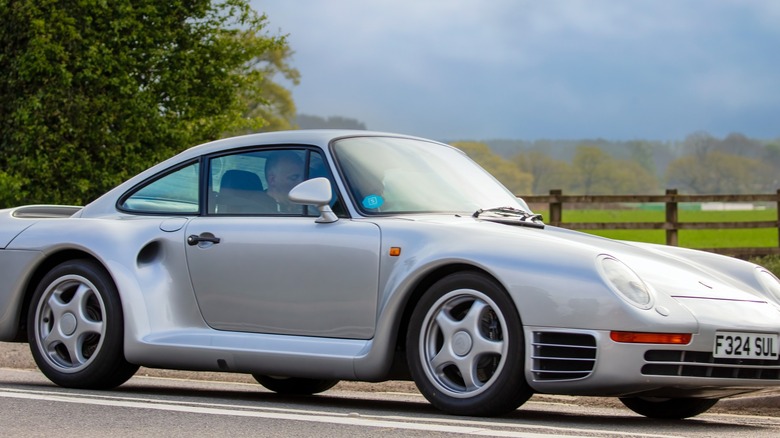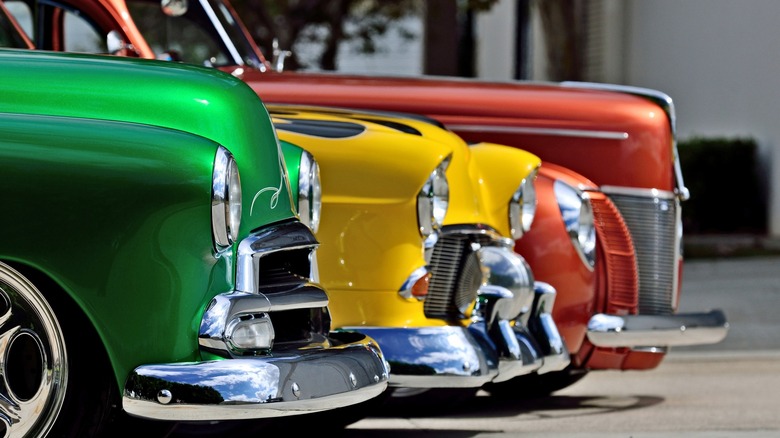Here's Why Some Of The Coolest Cars Aren't Sold In America
America misses out on a bunch of cool cars that are common in other countries. And it's not just about how these cars look or how fast they go; many of them have pretty awesome features, are super efficient, and are totally fun to drive. They reliably catch the attention of car enthusiasts all over the world, and you might have seen some of them on social media.
So, why don't we see more of these cool cars in the United States? Is it because Americans don't like them enough to bring them over, or are they just too expensive? Or maybe there are laws and rules making it hard for these cars to be imported?
We're going to dive into the reasons that affect this, so that next time you fawn over a Toyota Aygo or an Alpine A110, you understand why you can't just go out to get one and drive it around on American roads — at least not yet.
Americans love big cars
When you take a look at the cars in mall parking lots or speeding by on the highway, it's pretty clear: Americans have a thing for bigger cars. Ask around, and you'll hear that many people consider bigger cars to be comfier, safer, and just right for the American way of life.
Whether it's for cruising through the city or taking on cross-country adventures, these larger vehicles offer plenty of room for both people and all the stuff they like to bring along on trips.
Contrast this with Europe and Asia, where narrower streets and higher gas prices make smaller cars a smarter choice. That doesn't mean Americans don't care about saving on gas — they do. It's just that fuel efficiency often gets overshadowed by the appeal of a car's speed and other amenities.
And the fact that most Americans clearly prefer bigger cars is one reason we don't see some of the coolest compact and fuel-efficient cars on U.S. roads. And car companies really want to sell what most Americans are buying.
The CAFE standards
Interest in bigger cars generally got a big nudge from a policy known as the CAFE standards (Corporate Average Fuel Economy). Introduced by the government in the 1970s, these rules require car manufacturers to hit a certain fuel efficiency average across all their models.
Because the rules are not as stringent on bigger cars as they are on smaller cars, it's often easier for light trucks and SUVs to meet the standard requirements. Plus, there's more profit to be made on larger vehicles.
These standards make it more attractive for carmakers to churn out bigger vehicles, such as SUVs and trucks, rather than their smaller, more fuel-efficient counterparts, like sedans.
As a result, the market has seen a surge in bigger cars. For instance, American carmakers like Ford and General Motors have dialed back on distributing sedans and other smaller cars in the United States.
Companies such as Suzuki, which played a crucial part in the market decades ago, have, over the years, disappeared from the country's automobile scene. However, the shift towards EVs could potentially change the narrative. But then there's the big question: Is the U.S. really ready for an EV revolution?
America's safety standards
If a car company wants to sell a car in the U.S., Europe, or Asia, they often need to produce different versions to meet each region's distinct safety standards. In America, car manufacturers have to comply with the Federal Motor Vehicle Safety Standards (FMVSS), while many other countries work with the UNECE standards. The difference between standards puts most carmakers in a bit of a pickle. The cost of making these modifications isn't pocket change. It requires significant investment in design, testing, and certification processes.
The Suzuki Jimny is a great example of a cool, compact SUV that's loved worldwide for being tough, affordable, and great off-road. But, it's not available in the U.S. This isn't just because Suzuki stopped selling cars in the U.S. The main reason the Jimny isn't seen on American streets is that it wasn't designed to meet America's car regulations. Essentially, the Jimny doesn't fit into the American rules for safety and emissions, so it can't be sold or driven legally in the States.
If a carmaker isn't confident that a particular model will sell well enough in the U.S. to justify these costs, they might decide it's not worth selling that model stateside. And that's why some cool, efficient, or just plain interesting cars don't make it into the U.S. market.
The 25-year import rule
The United States is pretty strict about which cars can be driven on its roads. When cars aren't made for the U.S. market, you have to wait 25 years before it's legal to bring them into America. Why does this rule exist? It's mainly because of safety reasons. When new, these foreign cars might not meet the America-specific safety and pollution standards.
Because of this rule, many really cool and unique cars made in other countries can't be easily brought into the U.S. and driven on public roads. So, if there's a fancy new sports car or a unique model that's only sold in Japan or Europe, you can't legally import and drive it here right away. You have to wait until it's old enough to be considered a "classic" under the law. Some of the coolest foreign cars from 1999 are finally legal to import in 2024.
There's also a special exception called the Show and Display rule. This lets some rare or important cars come to the U.S. even if they're not 25 years old yet. But there are strict requirements, which stipulate that only 500 of these cars can exist worldwide, and you can't drive them much — no more than 2,500 miles in a year.




